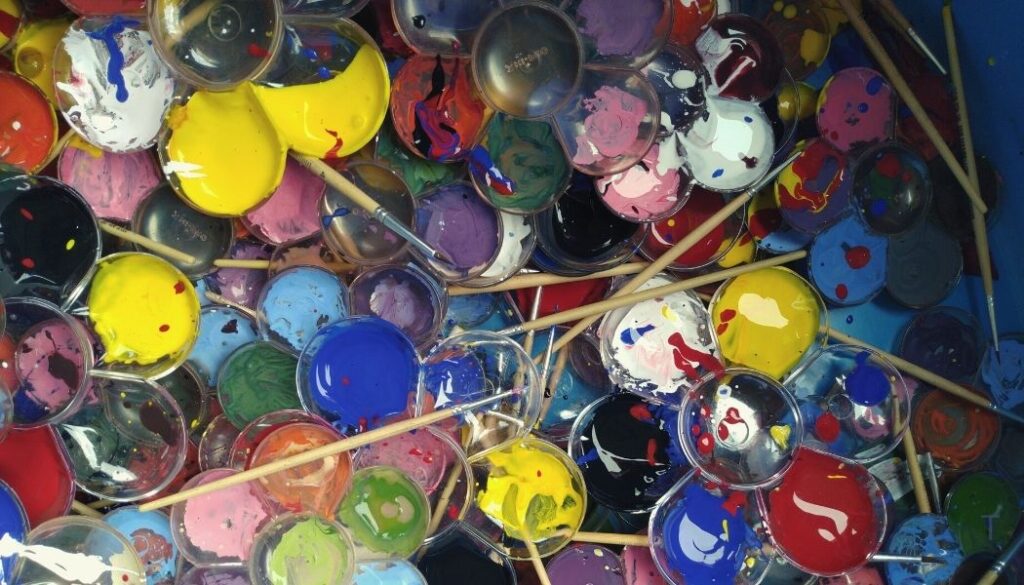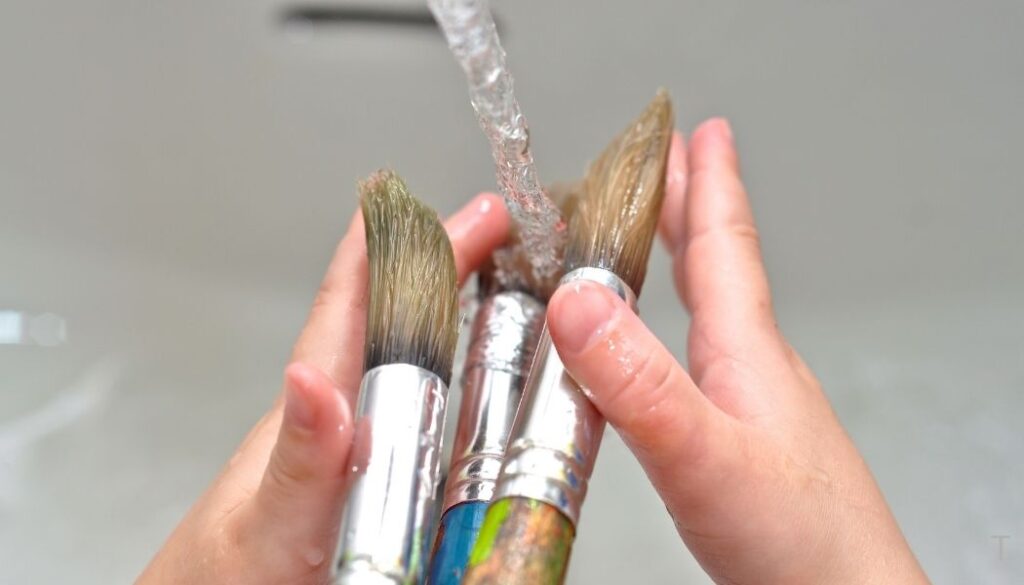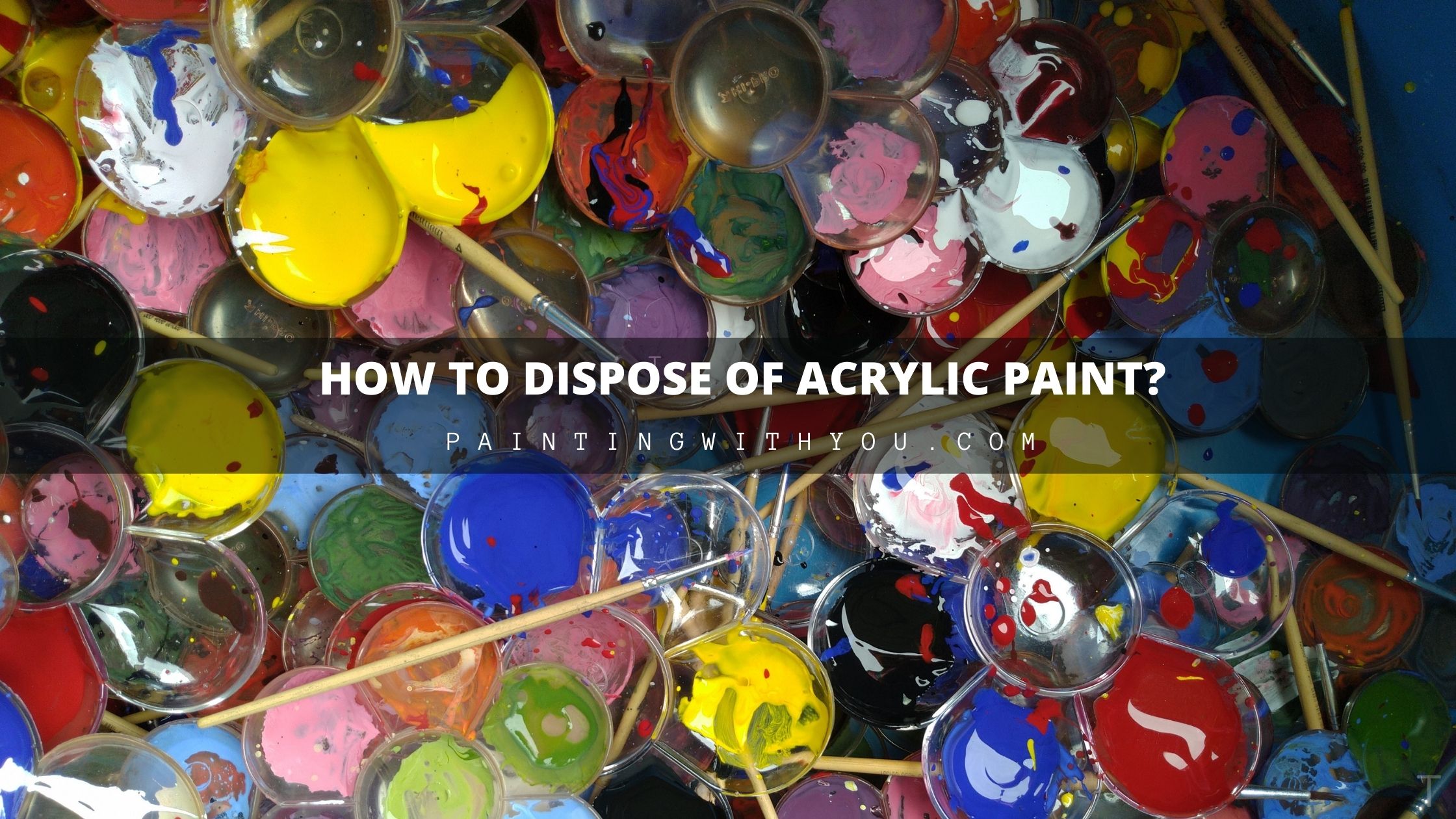There’s a good chance that you have come in contact with some acrylic paint before. It’s essential that after using up your tins containing acrylic paint, you dispose of them properly. Most people dump empty cans of acrylic paint in the trash can without thinking about the harm it could cause.
To dispose of acrylic paint, recycle it or dry it out first to avoid potential pollution. Some acrylic paints are made with toxic chemicals that shouldn’t be tossed into the trash. You could also dispose of your paint by giving it away to others.
In this article, I’ll be providing all the information you need on how to rightly dispose of your acrylic paint, especially those that are toxic. I’ll also show you ways to identify which paints are toxic and which are not.

Is Acrylic Paint Considered Hazardous Waste?
Water-based acrylic paint is non-toxic, but the moment harmful chemicals such as lead, manganese, cobalt and others are added to the paint, it becomes toxic.
When acrylic paints contain harmful chemicals and heavy metals, they become toxic. Such toxic waste can affect not only humans and animals but also the environment in general.
Acrylic paints aren’t considered to be hazardous waste. However, the fact that they’re non-toxic doesn’t make them suitable for the environment; since the material generally has certain chemicals that are not recognized as eco-friendly.
Like any other waste product, you have to properly dispose of your acrylic paint to prevent it from harming the environment. As much as possible, avoid putting acrylic paints in your garbage can. If you ever need to put them in your trash, make sure that they’ve already dried up and gotten solidified.
Can You Recycle Acrylic Paint?
You can recycle acrylic paint if it is water-based. However, oil-based acrylic paints cannot be recycled. Keep in mind that even some water-based paints may contain toxic ingredients and should not be recycled.
Acrylic paints are generally water-based. However, where the acrylic paint is toxic despite being water-based, it can’t be recycled.
How To Dispose of Acrylic Paint?
There are several straightforward ways by which you can dispose of acrylic paints. Generally, one way is by simply giving out whatever leftovers to schools, charities, or whoever needs them; you can also recycle the leftover acrylic paint or let the paint dry out and then throw it out. In doing all of these, you have to take note of whether the paint is toxic or not.
Before proceeding, you should know that excess Acrylic paints can be avoided by purchasing only what you need at a time. This way, you’ll likely end up with completely empty bottles — that only need recycling — rather than paint-filled bottles that need disposal.
You can dispose of non-toxic acrylic paint by simply leaving the can open and let it dry out, after which you can then throw it out. If the acrylic paint is toxic, you can dispose of it by taking it to any facility around you to dispose of hazardous waste.
TIP: You can also fasten the paint drying process by adding sawdust or shredded paper to the leftovers. Also, if your acrylic paint doesn't contain any chemical harmful to the environment mentioned above, you can recycle it.
Can You Pour Acrylic Paint Down the Drain?
Generally, it’s not ideal to pour paints down your drain. In answering this question, you need to understand that acrylic paint polymers are some form of plastic.
You can’t pour acrylic paint down the drain because of its plastic component, which is usually toxic in nature; even acrylic paints that are non-toxic tend to end up not being eco-friendly.
When you pour the paint into your drain, it goes down along with the plastic particles into the water system, which would, in turn in one way or the other, flow into the sea; and like that, the harmful particles pollute the environment.

Can You Wash Acrylic Paint Brushes in the Sink?
You can wash acrylic paint brushes in the sink after wiping off the leftover colors from your brush and rinsing whatever paint is left in a cup of water. Take care to then drain the water with the acrylic paint into a sieve to prevent it from flowing into the sink.
There are several ways in which you can wash your acrylic paint brush in your sink and avoid the paint going down the drain and flowing into the water system, but it requires you to take care.
One crucial step you should take when washing your acrylic paint brushes in the sink is to clean out all the excess paint left on the brush with a rag or a paper towel.
NOTE: Rinsing out your paint brushes in your sink means that you have made provision for whatever leftover paint residue to be sieved out to prevent it from flowing into the water system.
How To Dispose of Acrylic Paint Water?
I’ve mentioned that if you’re not careful in disposing of your acrylic color water, you may end up causing environmental pollution by the release of toxic paint waste. To dispose of the water from acrylic paint or water used in rising off acrylic paint, you can use a filter. The filter would sieve out the lumps of paint.
You can also make use of a cat litter used for removing clumps; all you have to do is, get an empty bucket or gallon, place the cat litter at the bottom of the bucket and then pour your paint water in it; once it clumps you pour out the water and throw the clumps of leftover paint in the trash can.
Another step you can take is to leave the water to evaporate and then dispose of whatever remains of the paint.
It may not be easy for acrylic paint to solidify with water in it. To make the process of solidification fast, you can pour the acrylic paint water into a metal coffee pot and then leave it on a steam radiator. The method of evaporating the paint water depends on the weather and humidity at that particular time.
Can You Recycle Acrylic Paint Bottles?
Generally, you can recycle acrylic paint bottles. The fact that the paint is toxic or not friendly to the environment doesn’t mean that you can’t recycle the paint bottle. Where you have to be careful is in properly disposing of the acrylic paint contents of the bottle.
The first thing to look out for when you want to recycle these acrylic containers is that the bottles are by-products of substances that you can recycle. The next step is to observe the label on the bottle to see if your local recycling center accepts such bottles for recycling.
Once you’re sure that you can recycle the container, the next thing is to dry out the paint, remove it from the bottle, and dispose of it properly.
Frequently Asked Question
To preserve acrylic paints, seal off the paint in an air-tight container will keep it from drying out. You can cover its exposed bottle with some plastic wrap, or seal it off with a secure lid.
The whole idea is to keep the paint’s water content from escaping. So, instead of rushing to dispose of leftover Acrylic paint, protect its texture by sealing it off. You may also use excess paints to prepare the board or canvas for future use.
The best way to dispose of over a gallon of acrylic paint is to give it out to those who need it, such as a school or painting workshop. You can also leave it to dry out and then throw it away. If the paint won’t dry quickly because of the large volume, pour a paint hardener into it.
You can use your acrylic paint bucket or can for other things so far you have disposed of the acrylic paint in it the right way. It can be recycled and as a form of storage for different things. You have to ensure that every iota of paint is removed from it.
Acrylic paint could be toxic or non-toxic, depending on the type of materials and chemical components making it. Either way, acrylic paints are generally not environmentally friendly.
Key Takeaways
So long as your acrylic paint isn’t toxic, you can either recycle it or throw it away. Should the paint have harmful chemicals, then you will need to take it to a special facility for safe disposal. Whenever possible, it’s ideal to recycle any unused paint or donate it for reuse.

